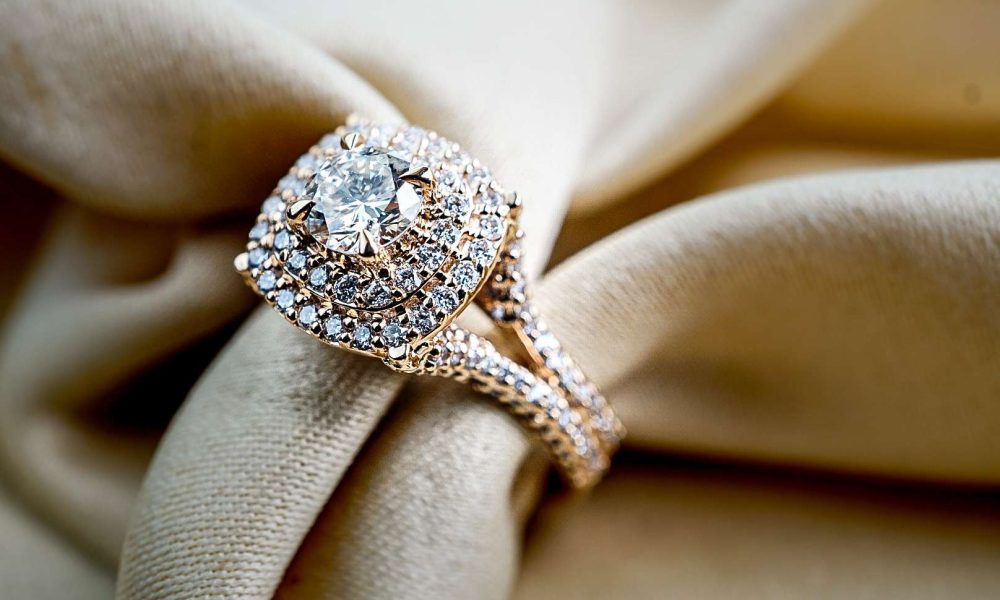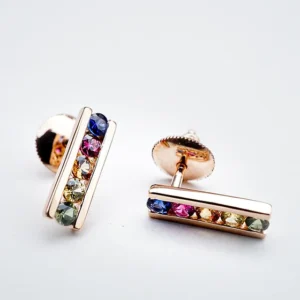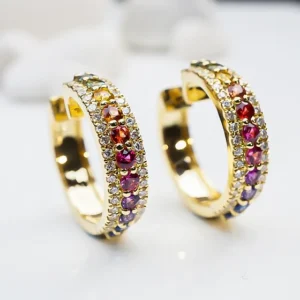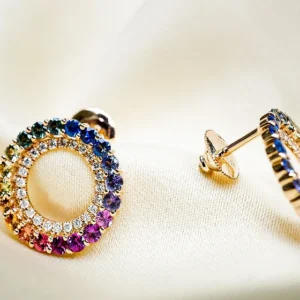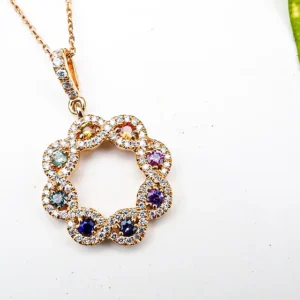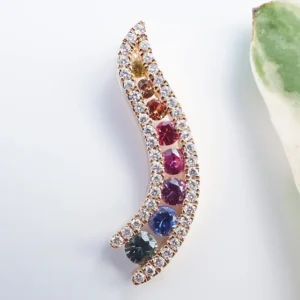Diamonds: Unveiling the Sparkling World of Precious Gems
Diamonds have captivated humanity for centuries, admired for their exquisite beauty and enduring symbolism. From engagement rings to royal crowns, these precious gems have held a special place in our hearts.
Table of Contents
These gems are more than just precious stones; they are symbols of love, luxury, and endurance. Their dazzling brilliance and rare beauty have made them coveted treasures throughout history. In this article, we’ll delve into the fascinating world of these gemstones, exploring their history, characteristics, valuation, and more.
The Formation of Diamonds
Diamonds form deep within the Earth’s mantle, subjected to intense heat and pressure. Carbon atoms arrange in a unique crystal lattice structure, resulting in the formation of these gems. This process takes millions of years and involves volcanic activity that brings these gemstones closer to the surface, where they can eventually be mined.
The 4 Cs of Diamonds: Understanding Quality
When evaluating diamonds, experts consider the Four Cs (4 Cs): Carat weight, Cut brilliance, Clarity perfection, and Color spectrum. These factors determine a diamond’s overall quality and value, making them essential aspects to understand when purchasing or appreciating these gems.
Cut: The Art of Revealing Brilliance
A diamond’s cut determines its brilliance and sparkle. From the classic round cut to fancy shapes, each cut has its unique appeal. We will explore how masterful craftsmanship can maximize a gem’s visual appeal and value.
When it comes to these gems, the cut is a critical factor that unveils their true brilliance and splendor. The art of gem cutting involves the skillful shaping and polishing of rough gems to maximize their light performance and visual appeal.
A well-cut gem interacts with light in a way that showcases its inner beauty, scattering and reflecting light rays to create a dazzling display of sparkle and fire. The precision of the cut determines how effectively the gemstone captures and reflects light, making it the most influential factor in a gem’s overall beauty.
Various gemstone shapes, such as round, princess, emerald, and pear, offer unique characteristics and appeal to different tastes. Expert cutters consider the gem’s natural features and optical properties to decide on the ideal cut that will best enhance its brilliance.
A perfectly cut gem possesses optimal proportions, symmetry, and excellent polish, ensuring that light enters through the top and reflects back with maximum brilliance. A poorly cut gemstone, on the other hand, may leak light through its sides, resulting in a less vibrant appearance.
A well-cut gem not only enhances the gem’s beauty but also affects its value significantly. An exquisite cut can transform a gemstone into a show-stopping masterpiece, captivating hearts and leaving a lasting impression.
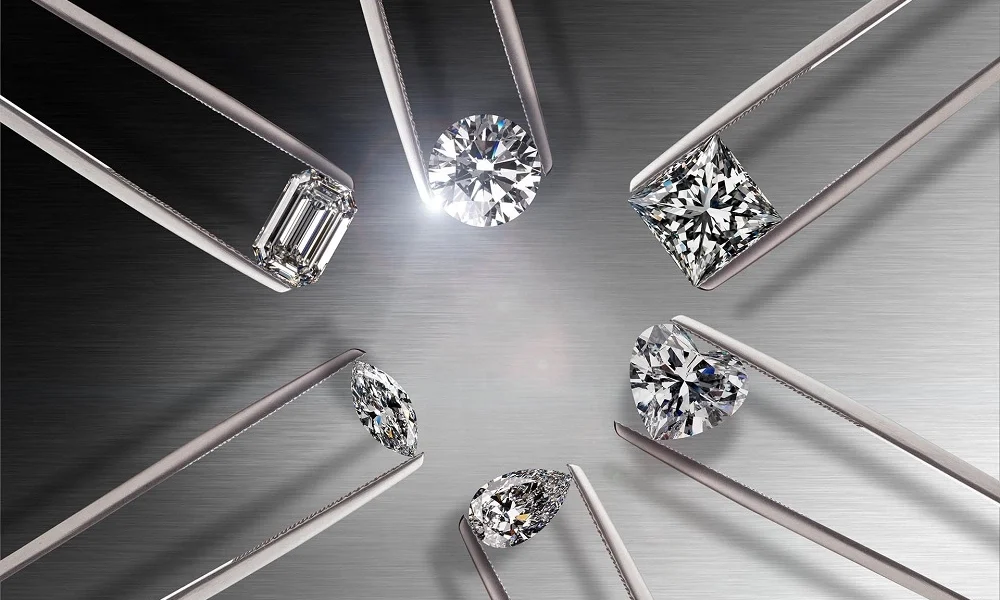
Perfectly Cut Diamonds
Color: A Spectrum of Beauty
Gems come in various colors, and their rarity increases as the colorless scale approaches absolute purity. Discover the subtle yet crucial differences that determine a gem’s color grade and how it impacts its overall desirability.
In the captivating world of gemstones, color plays a vital role in defining their allure and value. The color of a gemstone is graded on a scale that ranges from D (colorless) to Z (light yellow or brown). Gems with higher color grades, closer to colorless, are exceptionally rare and prized for their pure and brilliant appearance.
The absence of color allows light to pass through the gem effortlessly, resulting in a dazzling display of brilliance and fire. As the color grade moves down the scale, the presence of subtle tints becomes more noticeable, diminishing the gem’s overall brilliance.
Professional gemologists carefully examine gemstones under controlled lighting conditions to determine their precise color grade. Even the slightest variation in color can significantly impact a gem’s desirability and value.
Fancy-colored gems, those exhibiting intense hues like blue, pink, or yellow, are exceptionally rare and highly sought after by collectors and connoisseurs. These gems possess a unique and mesmerizing beauty that sets them apart from their colorless counterparts.
When choosing a gem, consider the balance between color and budget. Gemstones with near-colorless grades, such as G or H, offer an excellent compromise between beauty and affordability.
In the end, the color of a gem is a personal preference, as some may prefer the warmth of a slightly tinted gemstone, while others admire the brilliance of a colorless gem. Whatever the choice, each gem on the color spectrum possesses its own beauty and charm, making it a treasure to cherish for a lifetime.
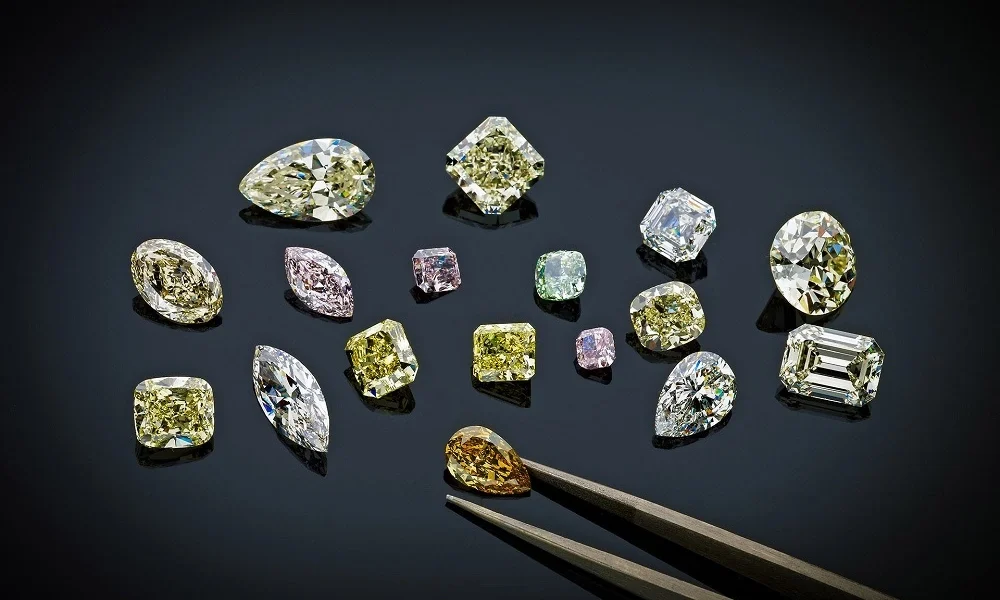
Spectrum of Colored Diamonds
Clarity: The Beauty of Perfection
Flawless gems are exceptionally rare and highly prized. We will explore the clarity grading system and understand how internal and external characteristics affect a gemstone’s brilliance and value.
In the captivating realm of gemstones, clarity is a captivating attribute that defines their enchanting allure. Clarity pertains to the existence or lack of internal and external imperfections, namely inclusions and blemishes, correspondingly. A gemstone with exceptional clarity is considered pure and flawless, captivating hearts with its dazzling brilliance.
Gemologists use a precise grading system to evaluate a gemstone’s clarity, ranging from Flawless (no inclusions or blemishes visible under 10x magnification) to Included (inclusions visible to the naked eye). Each clarity grade signifies a unique story of the gem’s formation, adding to its individuality and charm.
Flawless gems, entirely free from imperfections, are incredibly rare and command admiration from collectors and enthusiasts alike. Gemstones with lower clarity grades may possess unique inclusions that create mesmerizing patterns, known as “nature’s fingerprints,” making them distinctive works of art.
While flawless gems are prized for their purity, gemstones with slightly lower clarity grades can offer exceptional beauty at a more accessible price point. With the right balance of clarity, brilliance, and budget, every gemstone becomes a captivating symbol of love and eternity.
Ultimately, the beauty of a gemstone lies not just in its flawless exterior but in the journey it embarked on from deep within the Earth, carrying with it the tale of its formation and becoming a timeless testament to the wonders of nature.
Carat: Weighing Value in Metrics
The weight in carats significantly influences a gem’s valuation. However, bigger doesn’t always mean better. We will discuss how the combination of the 4Cs ultimately defines a gemstone’s worth.
When it comes to gemstones, carat is a fundamental factor that determines their value and significance. Carat refers to the weight of a gem, with one carat equivalent to 200 milligrams or 0.007 ounces. The carat weight is a key consideration for gemstone buyers, as it directly impacts the gem’s size and perceived value.
Larger gems are typically more valuable than smaller ones, all other factors being equal. However, carat weight is just one aspect of a gemstone’s overall value, as the quality of the cut, color, and clarity also play crucial roles in determining its worth.
Choosing the right carat weight involves finding a balance between personal preferences and budget constraints. While larger gems may be visually impressive, smaller gemstones with exceptional cut and brilliance can exude the same allure at a more affordable price.
It’s essential to remember that carat weight alone does not define a gem’s beauty or significance. The perfect gemstone is a harmonious combination of carat weight, cut, color, and clarity, creating a unique and breathtaking gem that will be cherished for a lifetime.
In the end, the decision on carat weight comes down to the individual, and whether it’s a delicate solitaire or a stunning statement piece, every gemstone has its own beauty and value that speaks to the heart of the wearer.
Beyond the 4 Cs: Additional Considerations
While the 4 Cs provide a solid foundation for evaluating these gemstones, there are other essential factors to consider when choosing the perfect gem:
1. Diamond Shape
Diamond shapes are a world of aesthetics. The classic round cut radiates timeless love, while the princess cut exudes modern elegance, and the emerald cut offers a vintage charm. Marquise and pear shapes add drama and uniqueness, while heart-shaped diamonds evoke romance. Each shape has its allure, allowing you to choose one that complements your style and sentiment, making your jewelry a reflection of you.
2. Certification
3. Fluorescence
Fluorescence pertains to how a diamond responds to ultraviolet light. While some of these gems exhibit fluorescence, it can affect their appearance in natural light. It’s advisable to view a gem under various lighting conditions to determine if its fluorescence is noticeable.
4. Setting and Metal
The choice of setting and metal for your diamond jewelry greatly influences its overall look and comfort. Whether you prefer the elegance of a solitaire setting or the intricate details of a pavé band, these choices should complement both the gem and your personal style.
Historical Significance of Diamonds
Throughout history, these gems have held immense cultural, spiritual, and romantic significance. Ancient civilizations believed these gemstones possessed mystical powers, associating them with divine protection and strength. In more recent times, these gems have become a symbol of everlasting love, making them a popular choice for engagement rings.
Diamond Mining and Ethical Concerns
The process of mining natural these gemstones has raised ethical concerns due to its environmental impact and potential human rights abuses. Conflict diamonds, also known as “blood diamonds,” have funded violent conflicts in various regions. Efforts to ensure ethical sourcing and responsible mining practices are crucial to address these issues.
The Art of Diamond Cutting
Diamond cutting is a meticulous art requiring precision and expertise. Craftsmen transform rough gems into polished treasures, enhancing their brilliance and value. Each cut, be it classic or unique, adds a distinct character to the diamond, influencing both its beauty and market worth. It’s a testament to human skill in enhancing nature’s marvel.
Famous Diamonds in History
Some diamonds have achieved legendary status due to their size, rarity, and captivating histories. Take, for instance, the famous Hope Diamond, renowned for its stunning blue hue and intriguing journey through time. These exceptional gems have a timeless appeal, transcending mere jewelry to become artifacts of history, inspiring awe and fascination worldwide.
Beyond Jewelry: Industrial Uses of Diamonds
Diamonds, while often associated with jewelry, hold immense value in various industrial applications due to their remarkable hardness. They excel in cutting, drilling, grinding, and find crucial roles in high-tech fields like electronics and medicine.
Whether it’s precision cutting or ensuring the efficiency of electronic devices, diamonds’ enduring qualities make them indispensable contributors to our modern world.
Investment Value of Diamonds
Diamonds are often considered a stable investment, but their value can fluctuate with market trends, rarity, and economic factors. Potential investors should conduct thorough research and understand the nuances of the gemstone market to make informed decisions about diamond investments.
Lab-Grown Diamonds vs. Natural Diamonds
The emergence of lab-grown diamonds has brought new options to the market. These diamonds possess the same physical and chemical properties as natural gems but are created in a controlled environment. The debate over their authenticity and environmental impact continues.
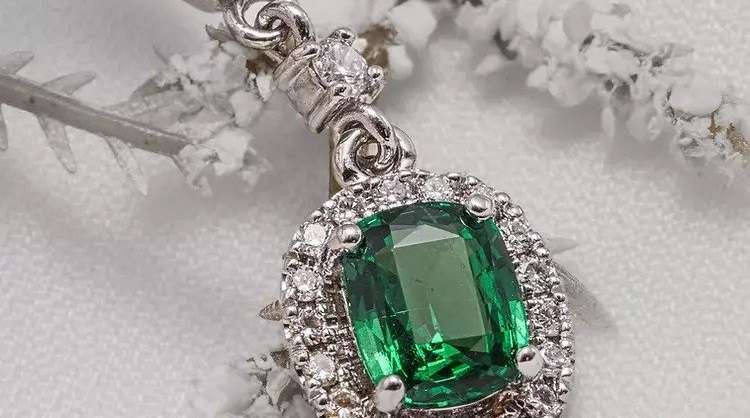
Pendant With Lab-Grown Diamonds
Caring for Your Diamond Jewelry
To maintain the brilliance of your gemstone jewelry, remember a few key steps. Regular cleaning, proper storage, and protection from chemicals and physical damage are essential. By following these practices, your gemstone pieces will retain their beauty and become cherished heirlooms for generations to come.
Diamonds in Popular Culture
Gemstones have made an enduring mark in popular culture, gracing movies, songs, and literature as symbols of luxury, beauty, and desire. Their timeless presence in our collective imagination speaks volumes about their universal appeal.
Unveiling the Diamond Industry: Myths and Realities
In the diamond industry, myths and misconceptions abound. To make informed choices, consumers should unravel these misconceptions, understand the diamond supply chain, and be savvy about marketing tactics. This knowledge empowers individuals to navigate the market with confidence and align their choices with their values and preferences.
The Future of Diamonds: Trends and Innovations
In this age of technological advancement, the gem industry is evolving rapidly. Trends like sustainable sourcing and blockchain-based certifications are shaping a more responsible and transparent industry. These innovations reflect a commitment to meeting the demands of a changing world where beauty is harmonized with ethics and sustainability.
Diamonds in Jewelry: An Enduring Symbol of Love
Engagement Rings: A Promise of Forever
One of the most iconic uses of diamonds is in engagement rings. These rings symbolize a promise of love and commitment. The brilliance and durability of diamonds make them the perfect choice for representing enduring relationships. The tradition of giving an engagement ring dates back centuries and continues to be a cherished practice.
The Diamond Ring: A Token of Affection
Beyond engagement rings, diamond rings are often gifted to mark special occasions. From birthdays and anniversaries to significant life milestones, a diamond ring is a heartfelt expression of love and appreciation.
Diamond Earrings: Adding Elegance to Every Look
Diamond earrings are a versatile accessory that adds a touch of elegance to any outfit. Whether they are simple studs or intricate dangle earrings, the sparkle of diamonds illuminates the face and enhances its beauty.
Diamond Necklaces: A Timeless Statement
A diamond necklace is a timeless piece of jewelry that can elevate any ensemble. Whether worn as a delicate pendant or a dazzling statement piece, a diamond necklace exudes sophistication and grace.
Engagement Rings for Women: A Deep Sentimental Value
Engagement rings are symbols of love and commitment, tailored to a woman’s style. From timeless solitaires to intricate designs, these rings reflect her uniqueness and mark the beginning of a beautiful journey.
Wedding Bands: Sealing Love with Diamonds
In addition to engagement rings, wedding bands often feature diamonds as well. These bands symbolize the eternal bond between partners, with the diamonds adding a touch of brilliance to the commitment they represent.
April Birthstone: Diamond's Radiant Reign
Diamonds hold the honor of being the birthstone for April. People born in this month are fortunate to have one of the most coveted gems as their birthstone, symbolizing purity, strength, and everlasting love.
Birthstones by Month: A Personal Touch
Birthstones bring personal meaning to jewelry, with each month associated with a specific gemstone. These gems, from January’s garnet to September’s sapphire, add a personal touch to accessories, connecting wearers to their birth month’s significance.
Lab-Grown Diamonds: Ethical and Sustainable Choices
For those who value ethical and sustainable options, lab-grown diamonds offer a compelling choice. These diamonds are created using advanced technology, reducing the environmental impact associated with traditional mining.
Diamond Stud Earrings: Timeless Elegance
Diamond stud earrings remain a timeless and enduring selection. They are versatile enough for daily wear while still adding a touch of sophistication to any look.
Exploring Diamond Settings: From Solitaire to Halo
Diamond settings play a crucial role in the overall appearance of the jewelry. From the classic solitaire to the modern halo setting, each style showcases diamonds in unique and captivating ways.
Final Thoughts: A Gem That Will Forever Shine
Diamonds have transcended both temporal and cultural boundaries to emerge as one of the world’s most coveted and beloved treasures. Their allure, which spans generations and civilizations, is an embodiment of timelessness.
Beyond their aesthetic magnificence, diamonds possess profound geological and historical significance, making them more than just gems—they are storied symbols of Earth’s ancient past.
This enduring appeal ensures that these precious stones will continue to enrapture hearts and inspire minds for generations yet to come. As contemporary consumers and industry stakeholders increasingly champion ethical practices and sustainable sourcing, the horizon of the gemstone industry gleams with promise.
This forward-thinking approach assures that the splendor of these exquisite treasures, which have become an integral part of our cultural and emotional tapestry, will be preserved for future generations to cherish and celebrate.
FAQs About Diamonds
Diamonds' rarity, beauty, and cultural significance contribute to their high value.
Yes, lab-grown diamonds have the same chemical composition and physical properties as natural diamonds.
The Kimberley Process Certification Scheme helps prevent conflict diamonds from entering the market.
While diamonds hold sentimental value, they may not always be the best financial investment due to market volatility.
Look for diamonds with certification from organizations like the Responsible Jewelry Council (RJC) or those using the CanadaMark™ system.
While diamonds are the hardest known natural material, they can still chip or scratch if subjected to strong impact or extreme pressure.
The largest diamond ever discovered is the Cullinan diamond, weighing an astounding 3,106 carats before being cut into several smaller gems.
Lab-grown diamonds have the same chemical composition as natural diamonds, while cubic zirconia is a different material altogether. The distinction lies in their optical, physical, and chemical properties.
Yes, synthetic diamonds and lab-grown diamonds are the same. Both are created in a lab and have the same properties as natural diamonds. The only difference is their origin – natural diamonds form over a long time underground, while lab-grown diamonds are made in a shorter time in a controlled environment.
Colored diamonds are indeed rarer than colorless diamonds. Their unique hues are caused by trace elements present during the diamond's formation.

